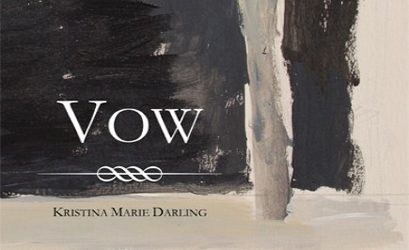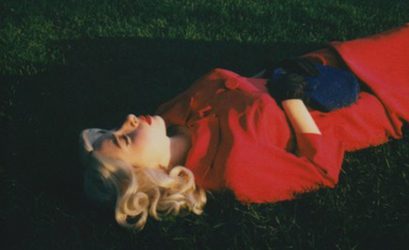 In The Bell Jar, Plath’s protagonist, Esther Greenwood, eschews expectations of marriage for writing, growing more and more disconnected from the other young women interns with her at the New York City fashion magazine. So Kristina Marie Darling’s poetry and prose unveils the stereotypes and double-standards embedded in our culture that make marriage imprisoning for many women. Given her history of experimentation with form, it is not surprising that her two most recent books, Vow and Music for another life., act in concert with each other and with the other literary works resisting these prescribed roles in works that incorporate both prose and poetry.
In The Bell Jar, Plath’s protagonist, Esther Greenwood, eschews expectations of marriage for writing, growing more and more disconnected from the other young women interns with her at the New York City fashion magazine. So Kristina Marie Darling’s poetry and prose unveils the stereotypes and double-standards embedded in our culture that make marriage imprisoning for many women. Given her history of experimentation with form, it is not surprising that her two most recent books, Vow and Music for another life., act in concert with each other and with the other literary works resisting these prescribed roles in works that incorporate both prose and poetry.
Vow is a book length poem that re-constructs (though incompletely) the remnants of a story, a treatise of vows, and the end of a marriage. Though easiest classified as poetry, it is the kind of writing that resists form as much as the voice in the book resists the constraints of marriage. In the first and main section of the book, “Vow,” we find what seems to be a story with narrative gestures seen in the prose blocks of text that begin with narrative syntax such as “I had always imagined the day” and “But before long, we’ll enter the house” However, as the first line asks “What does a white dress not resemble?” we may ask how does this not resemble story or poem. After all, the majority of this poem/story is filled with a sort of poetic negative space where footnotes and “marginalia” annotate empty pages. With this text, Darling tells and retells a story, recycling images of shattered glass, white dresses, a house without an exit, a house that can only be escaped through burning. Are these the ashes of that house, that marriage?
As it deconstructs the institution of marriage, so Vow also documents the construct, in the aftermath, of the poem itself. There are three appendices to the book and, in between them, “Endnotes to a History of Brides.” These sections act as commentary, supplement, and evidence for the first section. “Marginalia” contains more footnotes (this time numbered) to more blank pages. However, along with “Endnotes to a History of Brides,” rather than continuing the story, the notes seem to give background commentary, much as one might find in the commentary version of a movie, such as “This silver dagger was most often used for opening letters” or a direction for the reenactment of the story not told in the first part: “The film follows its heroine as she photographs the scorched altar….” This commentary adds context and a more distanced perspective to the story that “Vow” attempts to tell. Both are explanations for something that cannot be explained: why a marriage ends.
The other two appendices, “The Letter” and “Misc. Fragments” contain one to three lines per page, preserving the emptiness and fragmentation of the marriage depicted, acting as possible remains of the story that is told or missing. “The Letter” addresses a you, perhaps the bridegroom, it seems to look back on the burning. “Misc. Fragments” echo the images in “Vow” and appear as the original missing pages or fragments from which the poet constructed the poem. Thus, these two sections are given as the raw source material for the story of “Vow.”
 Music for another life. is a collaboration of prose poems or flash fiction narrating the 1950’s vintage-inspired photos of Max Avi Kaplan, which make the connections to Sexton and Plath all that more pronounced. In contrast to the emptiness, to the inability to completely tell the story in Vow this book’s flash fictions articulate Adelle’s disenchantment with marriage, its infidelities, and her journey to figure out just who she is outside of marriage:
Music for another life. is a collaboration of prose poems or flash fiction narrating the 1950’s vintage-inspired photos of Max Avi Kaplan, which make the connections to Sexton and Plath all that more pronounced. In contrast to the emptiness, to the inability to completely tell the story in Vow this book’s flash fictions articulate Adelle’s disenchantment with marriage, its infidelities, and her journey to figure out just who she is outside of marriage:
“Where will I buy a plane ticket for just me? Who will carry my small army of suitcases? I don’t know who to call my husband anymore, or what to call myself.”
It is this imagery, this inability of Adelle to imagine a life of independence that reinforces the vintage era of the photographs, though contemporary women, whether caught in abusive, unfaithful, or oppressive marriages or alone, still may find Adelle’s sense of loss and absence (“Every room seems like an ocean”), anger (“I carried our wedding china out to the dock, threw every goblet into the ocean”), desire (“But I keep waiting for a snow-capped mountain, even the smallest signs of life”) and loneliness (“I began inviting friends to celebrate my freedom, my unattachedness. I sent crisp little cards … the day arrived and my doorbell rang. When I opened the door, there was no one there.”) all too familiar.
Darling’s poetry and prose exposes the frailty of love, and marriage, but moreover of women’s moves towards liberation both within and outside of those contexts.




